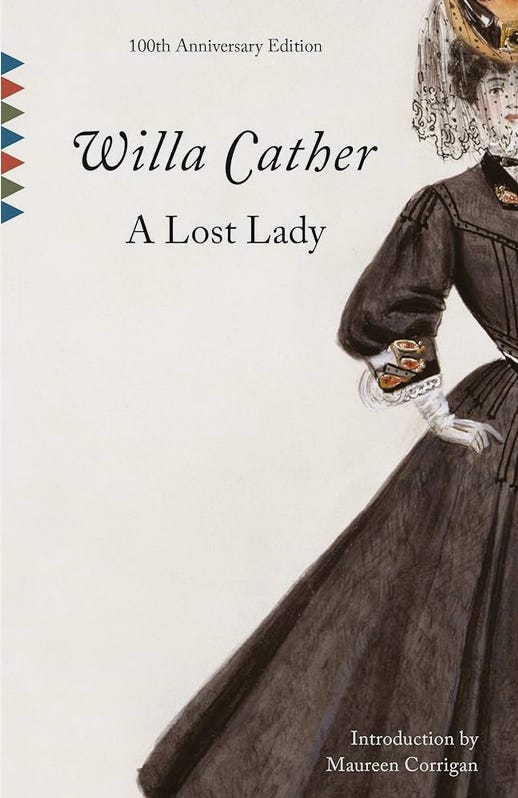What to Read Next: Moving Literary Classics
Issue #314, featuring Alice Walker, Barbara Kingsolver, and Willa Cather
Happy Friday, readers!
As I continue to reflect on my 2023 reading (still, I know!), I’ve realized that I read a lot of books and authors on my lifetime list. It was immensely rewarding and I’ll certainly continue strolling through the classics this year (especially Pulitzer winners) — while making plenty of room for fun stuff like Louise Penny and Game of Thrones.
This week, I’m sharing three of my favorite classic reads from the last handful of weeks, all of which were incredibly moving and will stay with me for years to come.
The Color Purple by Alice Walker
Published: 1982 | Pages: 290
Few books present as bleak an opening as The Color Purple:
You better not never tell nobody but God. It’d kill your mammy.
DEAR GOD,
I am fourteen years old. I am I have always been a good girl. Maybe you can give me a sign letting me know what is happening to me.
On the very first page, and in a rather graphic way, we learn that young Celie is being sexually abused by her stepfather.
Honestly, it was hard to keep going after that cruel first page. What kept me reading was simply knowing that millions of people before me had read the book and been moved by it. So I kept on, through more pages of Celie’s tortured existence, and I ultimately discovered one of the most powerful stories I’ve ever read.
Told as a series of letters (mostly from Celie to God, though Walker mixes it up a bit in the second half), The Color Purple tells a decades-long narrative about a group of Black women trying to survive the American South of the early 1900s. As the years pass, Celie, Shug, and Sofia experience plenty of pain, but they also learn how to find themselves and how to find sisterhood in each other. Ultimately, it’s a story about love, resilience, and empowerment.
I’ve never read anything quite like The Color Purple and doubt that I will again. It’s a uniquely powerful novel that’s incredibly heart-breaking, but also deceptively optimistic and hopeful. It easily deserves a 5-star rating and should be on everyone’s lifetime reading list. (As noted above, however, the language is graphic at times.)
A Lost Lady by Willa Cather
Published: 1923 | Pages: 150
Shortly after we decided to name our daughter Willa, I figured it was time to read some Willa Cather — one of America’s great and often underrated authors. In the last six years, I’ve read a few of her books and always come away so impressed with her writing and storytelling.
This year, one of my reading goals is to finish her canon. Most recently, I thoroughly enjoyed her short and potent A Lost Lady, published in 1923.
Narrated by young Neil Herbert, readers hear the story of the lovely and graceful Marian Forrester, the “flower of the old American West.” She’s beautiful, charming, and lives a pleasant life with her elderly husband in one of Nebraska’s small frontier communities. But as Neil grows up, he learns that the shiny veneer of the Forrester household isn’t as sincere as he once believed.
A Lost Lady is somewhat bleak, but for some reason it never really felt like it while reading. It almost functions as a fable for the old aphorism that “all that glitters is not gold.”
Cather writes the best frontier settings I’ve encountered, period. Her mix of natural descriptions with how that environment impacts the people living there is second to none. Though her Great Plains trilogy is a better starting point, this is a great (and quick!) read for anyone interested in exploring her work a bit further.
The Bean Trees by Barbara Kingsolver
Published: 1988 | Pages: 232
Few authors have been on my TBR as long as Barbara Kingsolver. After our book club chose The Poisonwood Bible as our February pick, I figured the time was right to dive into her work once and for all. Rather than starting with Poisonwood’s 500+ pages, though, I went first for 1988’s The Bean Trees, her first published novel (and only 230 pages to contend with).
Protagonist Taylor Greer grew up in Kentucky, and went through her teenage years with two primary goals: not getting pregnant and getting the hell outta dodge. She was successful on both fronts and when she makes it to Tucson, AZ — with a three-year-old American Indian girl named Turtle in the backseat — Taylor is on a path that will change her life forever.
While navigating a new place, a new role (interim mom), and new relationships, Taylor grows up fast by necessity. The Bean Trees is a hardscrabble story, for sure, but it’s also infused with big helpings of love, friendship, and growth.
Kingsolver, as would become her trademark, blends incredible environmental description with vivid, complex characters whose believability I never questioned. From this first book, it’s easy to see why she would go on to win the Pulitzer in ‘23 for Demon Copperheard. I’m really looking forward to reading more of her work this year and can happily recommend The Bean Trees to any reader.
Thanks so much for the time and inbox space. I deeply appreciate it.
-Jeremy





That introduction of The Color Purple gave me goosebumps! My next read for sure
I was so excited to see The Bean Trees on your list! It is one of my all time favorite books.